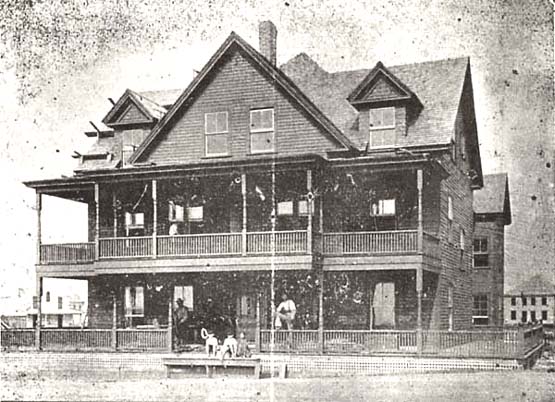From the Exeter News-Letter, April 19, 1901
Fire at Hampton Beach
From the Rockingham County Record, July 3, 1903
Fire was discovered in the front part of the Radcliffe house at Hampton Beach at about 7:45 Sunday evening and an alarm was quickly given to those within hearing. The house was owned by Duncan C. Roode, formerly of Exeter, who with his family had occupied it during the winter, and all were in the building at the time. The small force of men at the shore quickly responded and did telling work in removing a number of articles from the Radcliffe and in the more important work of preventing a spread of the flames.
A strong wind was blowing from the northeast, the fire gained headway rapidly and the building was soon a mass of flame, which quickly communicated to the large double cottage adjoining, the property of John M. Clark, of Exeter. The efforts of the volunteer firemen were aimed to prevent a spread of the flames to the buildings on the south, and only by well directed and persistent work was this accomplished. The heat from the burning buildings was so intense that their work in extinguishing the flames which were continually starting on the roof and sides of the nearby Glendon cottage, was hazardous in the extreme, but their efforts were kept up until all danger was over. Before nine the buildings fell in and the fire slowly consumed itself, leaving only a few charred timbers.
The tide being high at the time, water was easily obtainable, aiding greatly the heroic work of the Messrs. Ross, Nudd, Fisher, Jenkins, Curtis and J.S. DeLancey, members of the life saving crew and others, to whom too much praise cannot be given. Had the fire reached the long row of buildings, which extends almost without a break to the new opera house, now barely framed, the loss would have been a serious one, and disastrous in the extreme to Hampton’s interests. As it was the side and roof of Mr. Howard’s Glendon cottage is badly charred, showing how narrow was the escape.
Soon after the discovery of the fire an alarm was sounded from the power house gong, and Superintendent McReel, of the street railway, made immediate preparation to render assistance. At the request of the selectmen of Hampton, Chief Engineer Flanigan, of the Exeter department, dispatched steamer one and a hose carriage, each drawn by four horses. On arrival at Hampton depot, however, it was found that their services were not required, and they made a leisurely return. A special electric was furnished for the transportation of the firemen and some supplies, and the trip to the beach was made in 45 minutes, but there being no further danger their return was soon ordered. Three other cars carried a large number of spectators.
The Radcliffe was built in 1899 by Mr. Roode and was a large three story building of 26 rooms, with a large bath house and other smaller outbuildings, on which there was insurance of $4,500. He estimates his loss on buildings and contents at $6000. The Clark building was a double cottage of 12 rooms, partly furnished and with a large bath house in the rear. Mr. Clark carried insurance of $1000, but his loss will exceed $2,200. The cause of the fire is ascribed by Mr. Roode to the probable explosion of a kerosene lamp kept burning for the purpose of drying out one of the rooms that had been newly plastered.
Also read about the second fire to strike the Radcliffe, in 1909.
